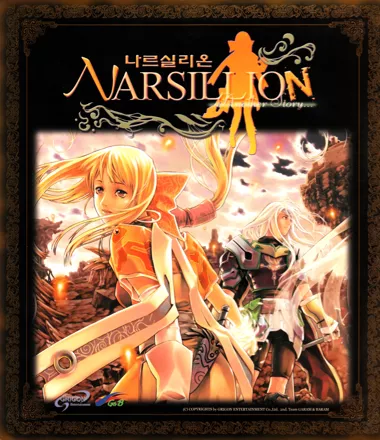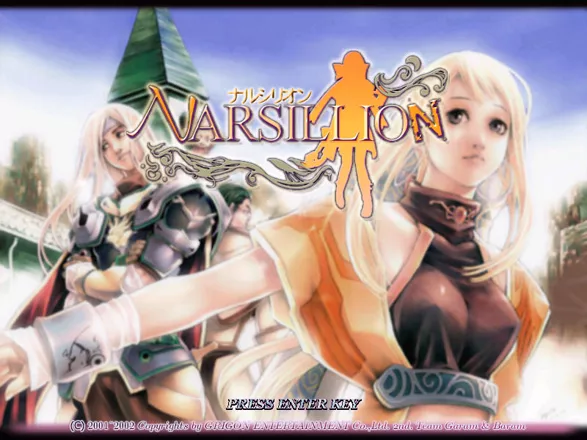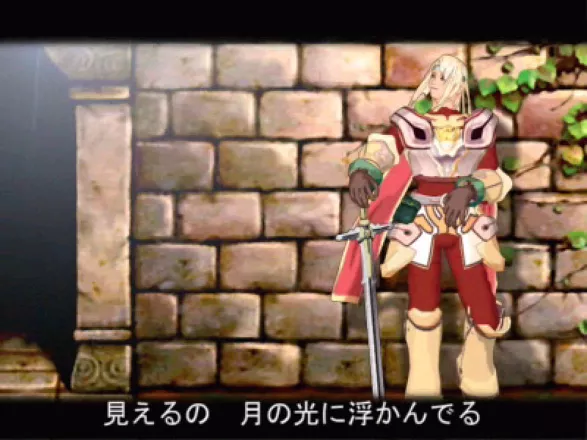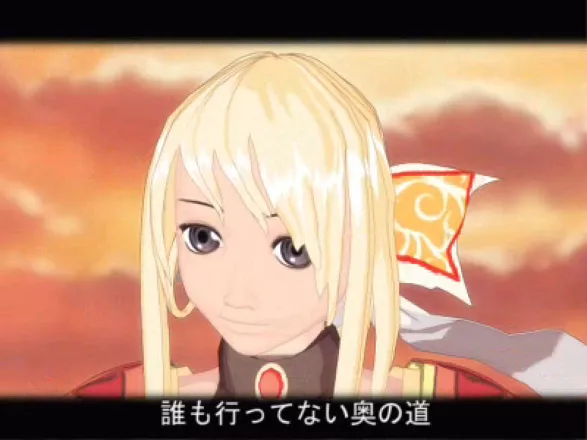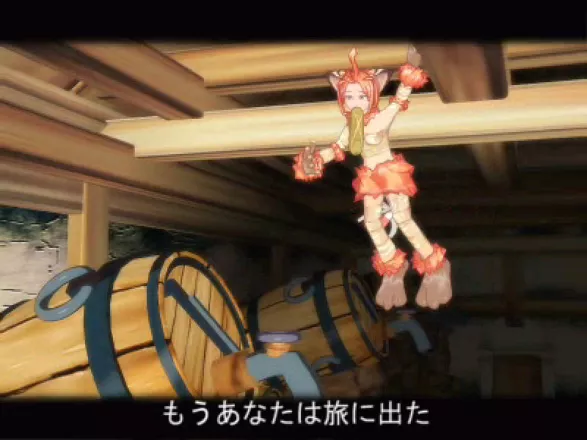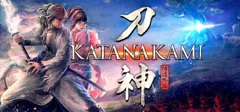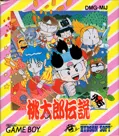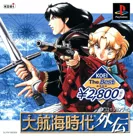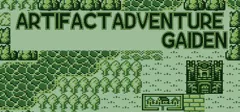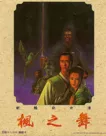Narsillion: Leithian Another Story
Description
Two countries, Temision and Halicarnassus, are at war with each other. King Ferdinand of Temision commands war magicians, hoping to gain the upper hand in the struggle thanks to their power. A girl named Leina was taken to the court of Temision when she was a child, and trained to become a prominent member of the team. However, as she completes another mission, she begins to have guilt feelings and questions the necessity to obey her superiors who order her to kill people. Very soon Leina begins to realize that even her love is jeopardized by politics and war.
Narsillion is a prequel to Leithian, telling the story that eventually led to the birth of Ellen, the heroine of the earlier game. Like Leithian, it is an action role-playing game taking place in vast interconnected environment consisting mostly of outdoor areas populated by enemies. The gameplay system is also similar to that of the previous game. The player controls a party of characters, manually fighting with the leader and assigning AI behavior (attacking, using abilities and items) to the rest of the team. Money gained from defeating enemies can be spent in towns on weapons, armor, accessories, and items.
Like in Leithian, accumulated experience does not result in leveling up. Instead, the player must find specific magic circles where he or she can freely distribute experience points to raise the heroes' attributes such as maximum HP and MP, attack and defense rating, etc.
Spellings
- レイシアン外伝ナルシリオン - Japanese spelling
- 幻舞天使外傳 桃色水晶緣 - Chinese spelling (traditional)
- 나르실리온 레이디안 외전 - Korean spelling
Groups +
Screenshots
Credits (Windows version)
43 People (31 developers, 12 thanks) · View all
| Exclusive Producer | |
| Producer | |
| Main | |
| Rough | |
| Galgum | |
| Main | |
| Helper | |
| Main Script | |
| Sub Script | |
| Main Character Modeling | |
| Sub Character Modeling | |
| Monster Character Modeling |
|
| Character Animation | |
| MAP Tile | |
| Background Object Modeling | |
| [ full credits ] | |
Reviews
Players
Average score: 4.0 out of 5 (based on 4 ratings with 1 reviews)
The Good
Narsillion is a prequel to Leithian, the first game released by the talented Korean developer Garam & Baram, and also the last game they ever made. Working with Grigon Entertainment in better conditions, the team succeeded in ironing out many of the predecessor's glaring issues while retaining its cool ideas.
Most Eastern RPGs abandoned action-oriented gameplay as defined by Nihon Falcom in favor of turn-based combat. Leithian tried to counter that with a system that preserved party management, the trump card of turn-based RPGs, but invigorated gameplay with fast-paced action. Narsillion is pretty much the same, but it is much more polished. One of its predecessor's biggest problems was lack of loot. Narsillion corrects that by learning from Diablo games and giving you plenty of randomized equipment. You get only a glimpse of what you'd normally have in Diablo, but it's already way better than the fixed system of most Eastern games. You'll be constantly managing your inventory and outfitting your characters in various ways.
Like in Leithian, you can decide yourself how to develop the characters you control, in a stark contrast to the automatic leveling of the vast majority of Eastern RPGs. You distribute accumulated points at special locations, essentially making your characters whatever you want them to be. It would make sense, for example, to raise the mana of your healer, but you may also decide that loading on mana potions and making him physically tougher by dumping points into his vitality would be a better strategy. This sort of role-playing is painfully absent from most Japanese-style representatives of the genre, and Garam & Baram deserves plenty of credit for choosing it.
Party management is fairly simple: you control directly only the leader (which you can switch), while the other characters are set on AI. You can manage their behavior by choosing an aggressiveness level of attacking, spellcasting, and using items, which is more than you could do in Leithian. More importantly, Narsillion gets rid of its predecessor's Achilles' heel - the non-existing challenge. The system is still open for exploitation, but at least not as blatantly as before, and if you don't raise the attributes of your characters you will die, which is the way it should be. Some areas you are not supposed to visit before the plot dictates it are still available for exploration, but this time you can count on resistance from tougher foes. The interface is also much more convenient, with hotkeys for spells and items replacing tedious menus.
Narsillion is also noticeably less linear than most other Eastern RPGs. Taking a cue from Garam's other work, the turn-based Seal, the game is spread across an interconnected world containing several towns, vast wilderness areas, and other places of interest. After you acquire your final party member rather early in the game you are pretty much free to go wherever you like. There are even some side quests given to you by various town inhabitants.
All this comes with a typically Asian emotional story, complete with likable characters, extended conversations, in-depth background for the world, and everything else we would expect from an Eastern RPG in the storytelling department.
The Bad
So, here we have it: a story-driven Eastern RPG with action, party management, manual character-building, lots of loot, non-linear exploration, and side quests. This sounds like a dream coming true. What could possibly go wrong to make all this goodness less than divinely enjoyable?
Alas, Narsillion is a testimony to the unrelenting, cruel truth: all the best intentions can be ruined by a single badly executed core aspect of design. No amount of cool features and brilliant ideas will ever be able to make up for the game's terrible environments.
Narsillion shares this crippling flaw with many other Korean games. I've seen it in Rhapsody of Zephyr and Corum III, two games developed by other notable Korean companies. It's a tremendous pity that well thought-out, interesting gameplay is set against the backdrop of identical locations. Even the towns look too much alike; but who cares about the towns if the largest portion of the game is spent exploring the wilderness, which is positively atrocious. You'll see the exact same grassy roads over and over and over again. If you've seen one cave, you've seen them all. You'll become insane simply from being forced to see the same screens way too many times. I can't fathom why Korean RPG developers keep accepting such inexcusable work.
There was also zero effort put into actually designing those areas. Any random generator would probably do a better job; but even games with random areas need a good designer to provide setting themes and details. Compare the unbearably bland world of Narsillion to Diablo II, which offered varied locations and even had the decency of adding features such as burning houses with cows inside here and there.
There are hardly any dungeons in the game, but the entire overworld and the few caves are built like huge monotonous mazes, which are a pain to explore. Adding insult to injury are feverishly re-spawning enemies. I can't stand excessive combat in RPGs, but when it occurs I want to have at least some option to avoid it. In Narsillion, even standing still in the same place will not prevent the same monsters from magically re-appearing in a few seconds.
Boredom inevitably sets in once you realize that character-building options have been wasted on primitive combat with very little sense of control: either you set your companions attack levels on "low" and then you die, or you set it on "high" and turn most of the game's screens into chaotic skirmishes without any sense of tactics and any challenge beyond madly mashing the attack button. You can't actually play as ranged characters, mages, or any other stuff that was fun to experiment with in Diablo games.
Thus the game's non-linearity turns from a blessing to a curse: you are free to explore, but exploring is not fun, so you feel you are forced to explore. You want to get it over with and just continue with the story, but you can't, since you don't know where you are supposed to go to - and even if you do, you'll have to endure painful identical screens infested by hyperactive enemies to get there.
Finally, it's a matter of taste, but I found the cartoony graphics of Narsillion lacking the serious warmth of its predecessor. These bright graphics with constantly rehashed textures and no detail anywhere but in the interiors of the buildings do not fit at all the game's nods to Western RPG either in world design or in the gameplay.
The Bottom Line
Narsillion is one of those games I really wanted to love, but couldn't. It tried very hard to follow the Western lead and become a deeper, more involving RPG, but neglecting fundamental aspects of the design ruined it. Good Eastern RPGs are like TV fantasy soap operas: they are supposed to give us drama and take us places, and that's exactly what Narsillion doesn't have. It is an important achievement for the creative development team and Korean RPG industry in general, but it fails to be enjoyable.
Windows · by Unicorn Lynx (181645) · 2016
Analytics
Identifiers +
Contribute
Are you familiar with this game? Help document and preserve this entry in video game history! If your contribution is approved, you will earn points and be credited as a contributor.
Contributors to this Entry
Game added by Unicorn Lynx.
Game added June 30, 2012. Last modified February 22, 2023.


